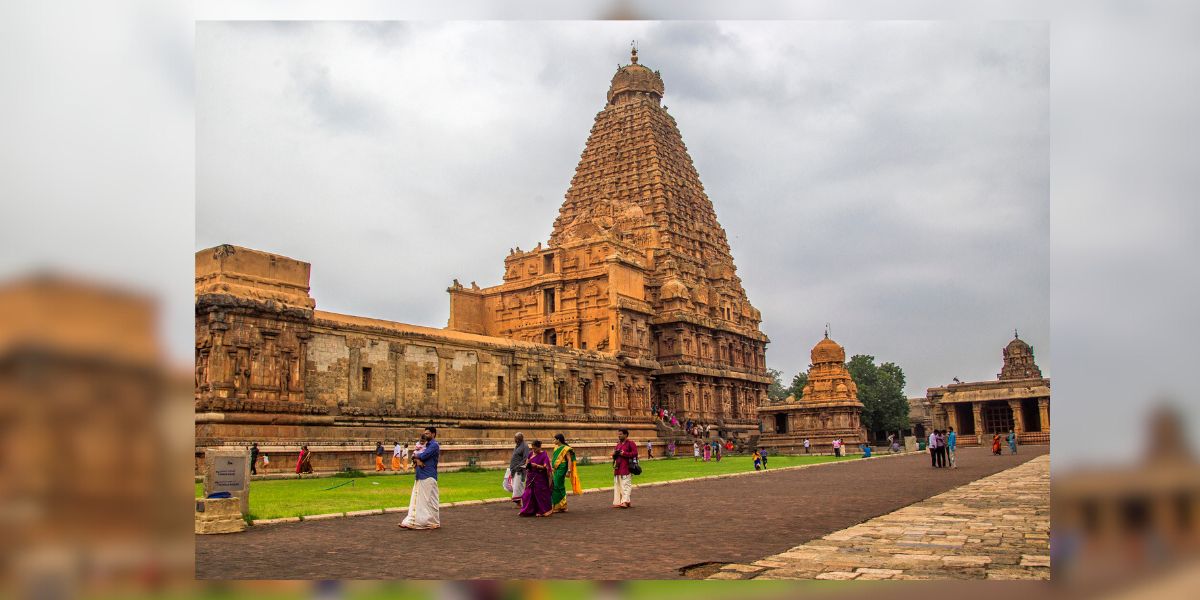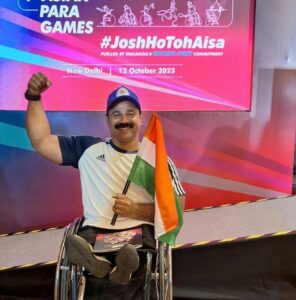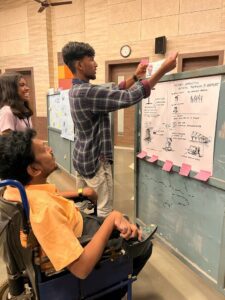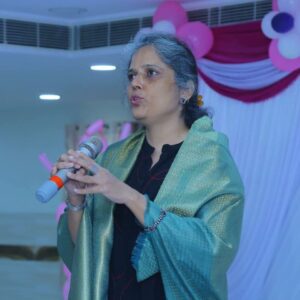Stakeholders explore opportunities to enhance inclusivity and accessibility for people with disabilities at heritage sites.

Brihadisvara Temple, a 11th century Chola Tamil temple and UNESCO World Heritage. (iStock)
India stands as a proud host to 42 UNESCO World Heritage Sites, solidifying its position as the sixth-largest country globally. The recent addition to this honour is the Sacred Ensembles of the Hoysalas in Karnataka.
Despite this wealth of heritage, India’s ranking in the Travel and Tourism Development Index of 2021, as assessed by the World Economic Forum, is only 54th out of 117 countries.
While maintaining its status as the top scorer in South Asia, one crucial focus area for the Indian government has been enhancing accessibility to the country’s heritage sites for people with disabilities (PwDs).
This Heritage Week, observed annually from November 19 to 25, government bodies, conservation architects, disability access auditors, individuals with disabilities, and organisations advocating for disability rights unite to identify existing gaps.
Article 30 of the UN Convention on the Rights of Persons with Disabilities (PwD), signed by India, recognises the equal right of the PwDs to participate in cultural life, including access to museums and cultural centers.
But, the lived experiences of the disabled tell a different story.
“As someone who is hard of hearing, I long for accessible experiences. For instance, visual representation through films on the specific monument or digital displays explaining its history. Sign boards are crucial for navigation. And, sign language interpreters can be immensely helpful,” shares Chennai-based Srivatsan Sankaran, founder of Madras Photo Bloggers (MPB).
The absence of communication facilities can lead to confusion, panic, and a disconnection from this rich history that the sites hold, he shares.
“Monuments in Mahabalipuram set an example with stone boards narrating the stories of monuments. But, challenges persist, as seen in other important monuments like Golconda or Senji fort. At these sites, relying on Google for information becomes the norm,” he elaborates.
Echoing similar challenges is Payal Kapoor, a 54-year-old disability strategist and consultant based in Hyderabad. She finds herself unable to fully explore the architectural wonders of her city, including the Charminar, Qutub Shahi Tombs, Salar Jung Museum.
Losing her vision to idiopathic intracranial hypertension at 22 and being partially deaf, Payal highlights the limited participation of disabled individuals in heritage walks organised by voluntary groups.
She often finds herself navigating alone, occasionally relying on the kindness of other participants for company. It’s not a practical solution, she says.
“Many heritage sites, especially those undergoing restoration, feature uneven surfaces, making the use of a cane unsafe. Elevators often malfunction. In such cases, audio guides become invaluable,” Payal adds.
Braille signages and tactile pathways aren’t the sole remedy, according to Payal.
“Moreover, a significant portion of the visually impaired population may not be proficient in reading Braille unless they are congenitally blind or exposed to it from a young age. At times, having a guide to walk with us is essential for ensuring our safety,” she notes.
The inability to physically access monuments confines their joy to merely imagining the experience, laments Payal.

Joby Mathew is an international arm wrestler from Kochi with orthopedic and physical challenges. (Supplied)
“Despite having disposable income and increased awareness, the desire to travel and appreciate our nation’s beauty is often hindered by the challenging process of reaching these places. This leaves us feeling more isolated,” she adds.
Joby Mathew, an international arm wrestler from Kochi, with orthopedic and physical challenges, has explored over 35 countries. However, he feels dejected that India is the least disabled-friendly.
“Despite my love for heritage, barriers present themselves at every turn — from Fort Kochi to the temples and Trivandrum palace in my hometown. Just three weeks ago, I was in Westlake in Hangzhou, China. Navigating everywhere in my wheelchair felt liberating. Why can’t we have similar facilities here? The general public and authorities must be sensitised,” he suggests.
Over 2.21% of the Indian population has one or the other kind of disability, according to the 2011 census of India. But, a handful of monuments are offering a wholesome experience to visitors — appealing to their aesthetic, historical, and intellectual senses.
Making this possible is Anubhav, a special tactile gallery nestled within the National Museum, New Delhi. This gallery exhibits 22 tactile replicas of museum objects. Each piece is thoughtfully selected from the extensive National Museum collection, providing a tactile journey through 5,000 years of Indian art.
The gallery has been developed with the help of UNESCO, Saksham (an NGO working with blind persons), Open Knowledge Community (OKC), Indian Institute of Technology, Delhi (IIT), and the National Platform for the Rights of the Disabled (NPRD). The gallery allows full tactile access accompanied by an audio guide and Braille labels.
It has been designed pro bono by architect Amardeep Labana and his team. The audio-guide and other interpretations have been developed with assistance from Siddhant Shah, who also works with museum and access.
“There is a growing awareness of the importance of making these places accessible, and numerous stakeholders have actively contributed to making this a reality. The inclusive features implemented can serve as models for other monuments,” states Muralidharan, General Secretary, National Platform for the Rights of the Disabled (NPRD).
Despite the initiation of the Accessible India campaign in 2015 and the enactment of the landmark Rights of Persons with Disabilities Act in 2016, Muralidharan feels that progress has been slow. However, adapting inclusive designs can revolutionise museum accessibility and overall experience, he says.
Pankaj Modi, Heritage Conservation Architect at the Indian National Trust for Art and Cultural Heritage (INTACH), Bengaluru chapter, shares, “Tipu Sultan’s Summer Palace in Bengaluru is an example of the practical use of a tactile pathway and Braille signage for the blind. In any monument, access, amenities, and interpretation services for people with disabilities play an important role. As architects, our responsibility is to ensure the thoughtful implementation of designs.”

Adapting inclusive designs can revolutionise museum accessibility and overall experience. (Supplied)
Chipping in, Poonam Natarajan, founder of the Spastics Society of India, presently known as Vidya Sagar, adds, “We’ve conducted workshops for architects, involving conversations with PwDs, to break down design barriers. Design for all, encompassing the elderly, pregnant women, and children, is crucial as anyone can become disabled at any time due to circumstances. I advocate for a compulsory module on universal design in architecture courses, underlining its importance to policymakers.”
Access isn’t reliant on extensive or costly renovations. It involves deploying design thinking effectively, insists Dr Aiswarya Rao, a disability rights activist based in Chennai.
Since 2015, Dr Rao has undertaken numerous accessibility audits. She has collaborated with individuals with diverse disabilities and orgnisations advocating for disability rights, for Metro stations in Chennai, the British Council library, and Madras Literary Society.
“Context is crucial. Conducting a straightforward audit, even at an ATM, is feasible. We can also conduct a comprehensive audit, providing multiple improvement suggestions. Although it’s a meticulous process, it is fundamental in determining the accessibility of a place,” shares Dr Rao, the founder of Better World Shelter for Women with Disabilities.
Precious landmarks in Chennai such as the Madras High Court, Egmore Museum Theatre and the old secretariat building at Fort St George lack accessibility.
“The installation of ramps and wheelchairs represents just the surface of inclusivity; there are broader dimensions to consider, ” adds Dr Aiswarya.
While many centrally protected monuments, including World Heritage Sites, have wheelchairs and ramps, it is important that different kinds of disability are recognised and every effort is made to accommodate them.
Each person is different and each disability manifests differently. Natarajan elaborates, “To genuinely embody inclusivity, we need to tackle engineering challenges from the perspective of diverse populations. Introducing small, miniature three-dimensional representations of monuments enables everyone to grasp their essence, particularly benefiting the blind. For individuals with intellectual disabilities, offering information in plain language enhances their visit.”
She urges the importance of taking into account motor skills, sensory perception, and cognitive functions at heritage sites.
Over the past decade, the ASI has been enhancing existing infrastructure to cater to the requirements of PwDs; particularly to those monuments under its Adarsh Smarak Yojana that experience significant tourist footfall..
“We are actively undertaking the task of rendering over 3,500 centrally protected monuments disabled-friendly in a systematic manner,” states SVP Halakatti, former ASI Director.
“In this endeavour, the UNESCO Heritage Sites take precedence,” he adds.
On 18 November, 2023, the Karnataka High Court suggested ensuring proper facilities at Hampi, one of the UNESCO World Heritage Sites, to boost tourism. The HC made this suggestion to the state government while hearing a PIL seeking the removal of illegal/unauthorised buildings in the vicinity of Sowmya Keshava temple in Nagamangala town of Mandya district.
Highlighting the distinctive challenges of implementing disabled-friendly measures in heritage sites, SVP Halakatti underscores the stark contrast with modern infrastructure.
“Heritage tourism holds paramount significance in India. The monuments ranging from temples to forts and palaces are often situated in remote locations. Each site requires an individualised approach to ensure the preservation of its heritage value,” he explains.
It’s crucial not to draw comparisons with Western designs, as our architecture boasts a unique identity, he urges.
“South Indian temples, with their unique architecture, often pose challenges due to elevated platforms and thresholds. Modern buildings offer more straightforward integration. But, for monuments, a detailed study is required. The commitment to protection involves collaboration among all stakeholders. This is not a one-day job. It needs to be pursued everyday besides regular preservation work,” he notes.
Involving experts from the fields of universal design, archaeology, engineering, and assistive devices is essential. Following up and measuring progress is crucial, believes Halakatti.
“Staff education and adopting modern technology like AI demand a thorough examination of available options. This is to ensure scientifically designed solutions for ease of movement. The aim must be to ensure that nobody feels left out and everybody has an integrated fulfilling experience,” he elucidates.

Payal Kapoor is eager to collaborate with the government and explore opportunities for inclusivity. (Supplied)
Individuals like Payal are eager to collaborate with the government.
“It’s the intent that matters, and if we genuinely want to make a difference, we certainly can,” she notes.
Mathew echoes this sentiment. Referring to Article 19(1)(d) of the Indian Constitution, which addresses the fundamental right to freedom of movement, he underscores the desire for an environment that supports free movement. A change that enables everyone to fully appreciate our heritage without seeking sympathy. “Isn’t it our basic right?,” he asks rhetorically.
Despite the myriad questions and challenges, there remains hope that change is on the horizon. As the International Day of Disabled Persons (December 3) approaches, it serves as a gentle reminder to envision a more inclusive future.

Mar 02, 2024

Mar 01, 2024

Feb 28, 2024

Feb 22, 2024

Feb 10, 2024

Feb 07, 2024